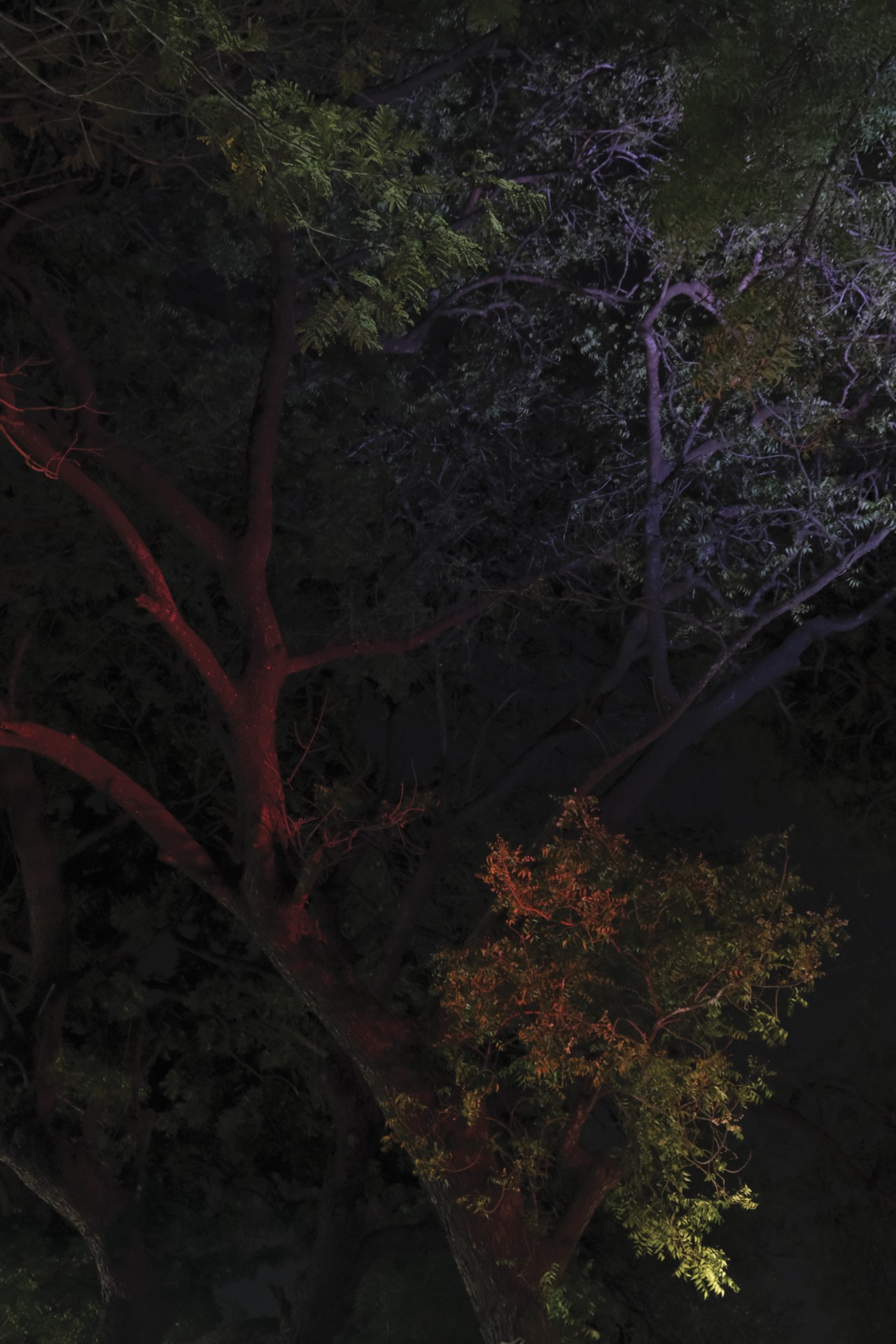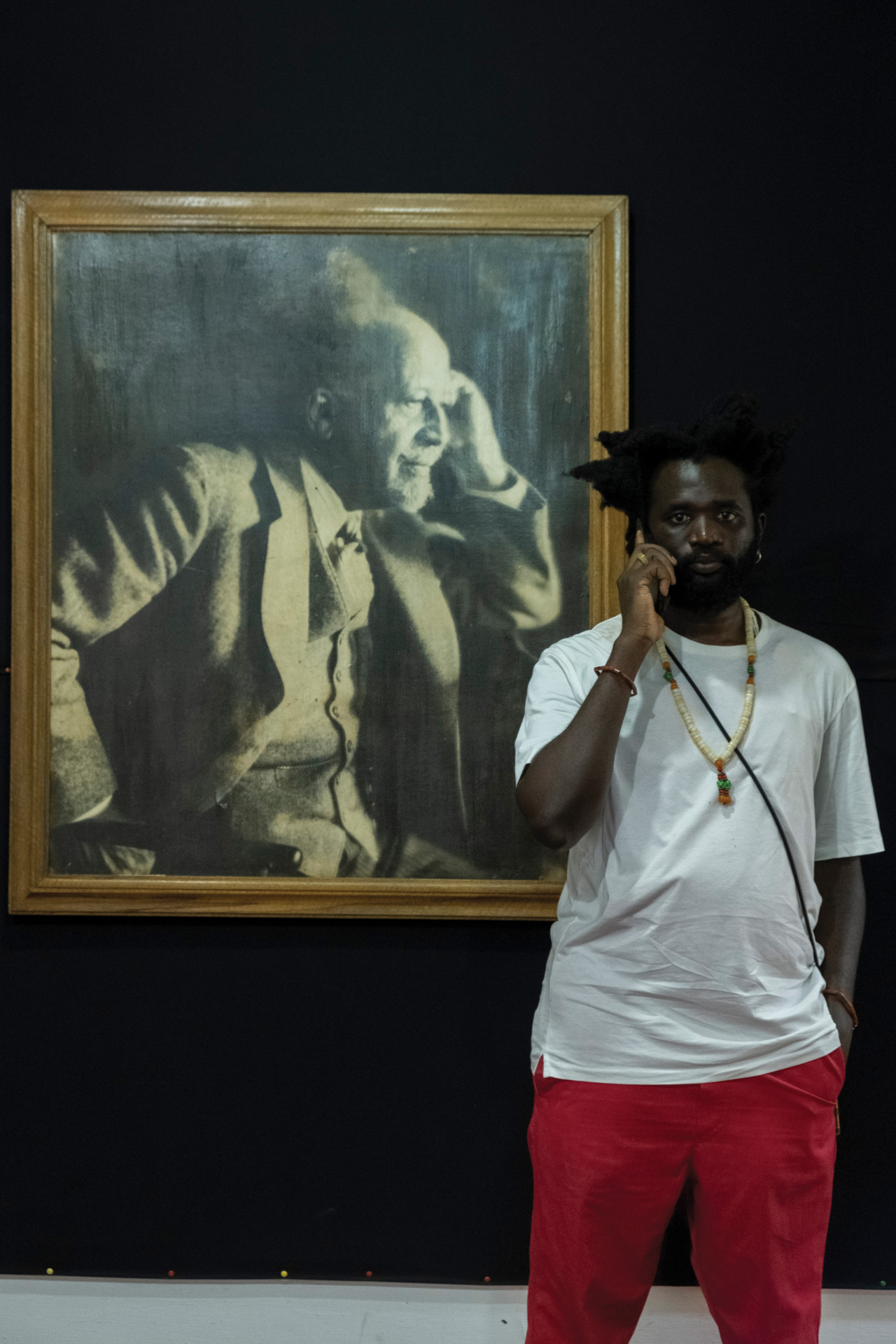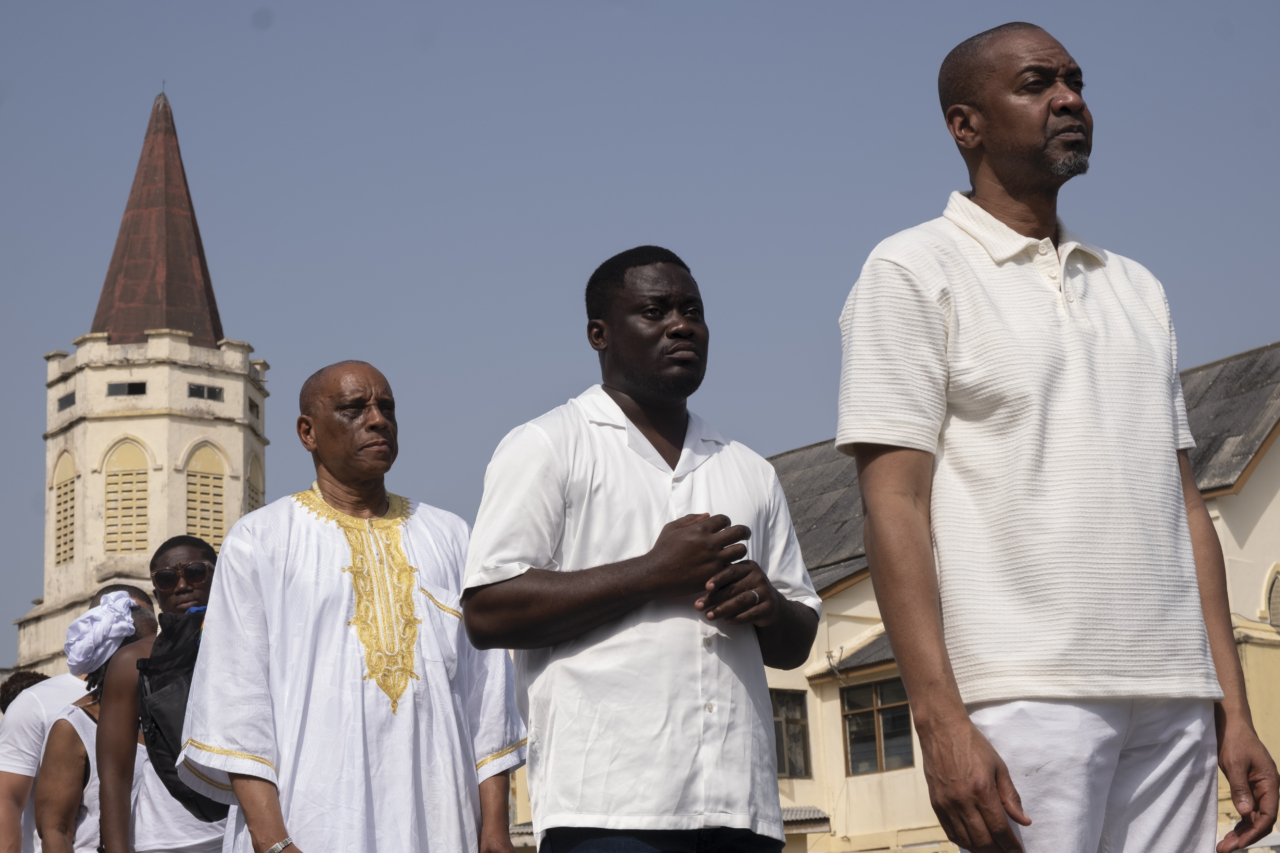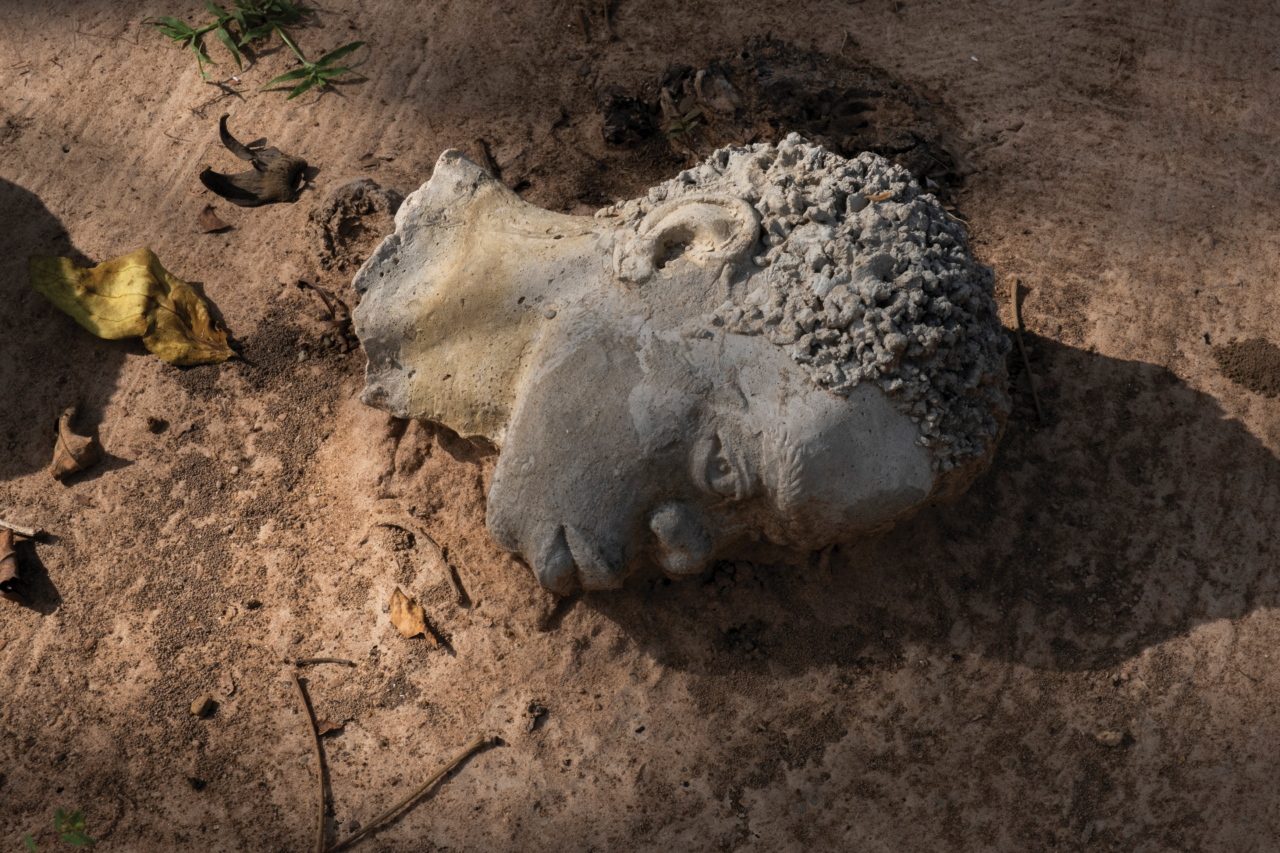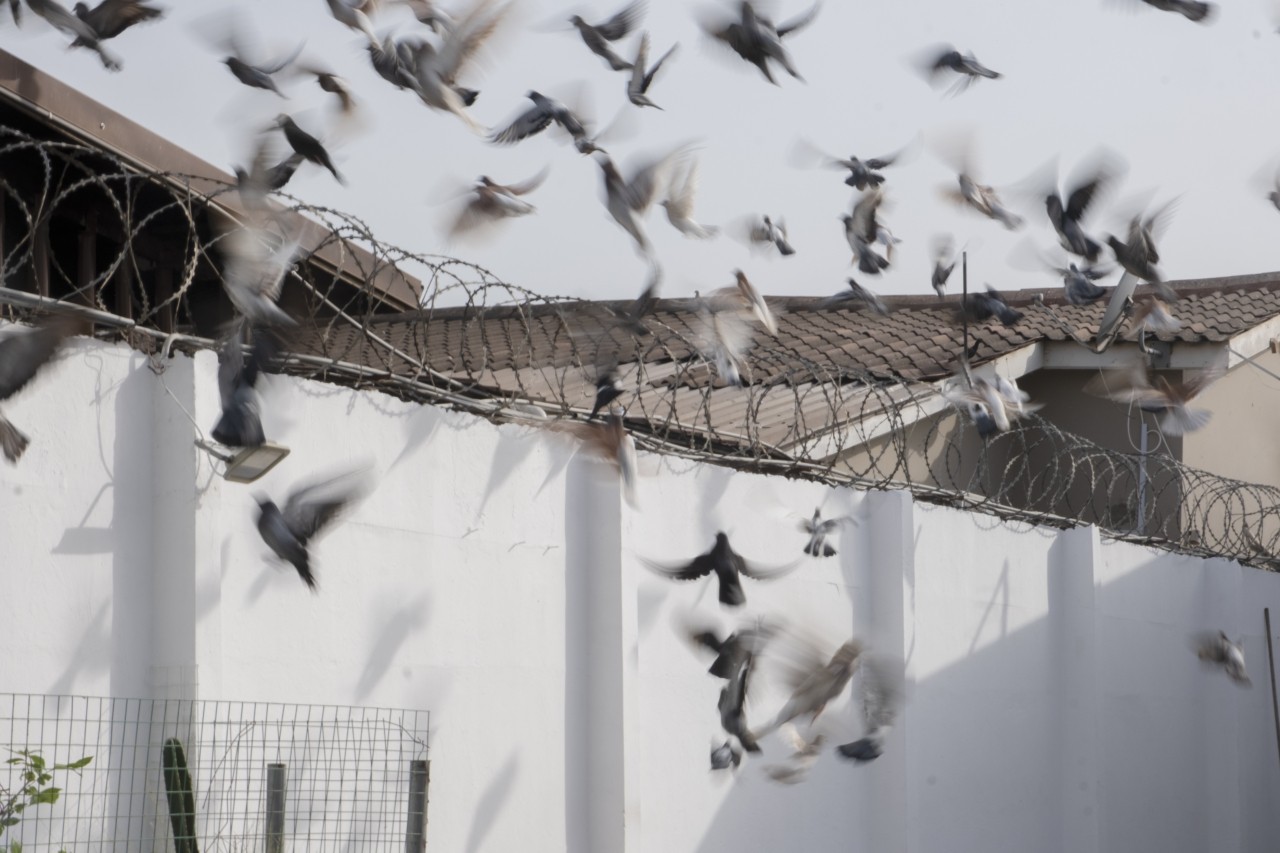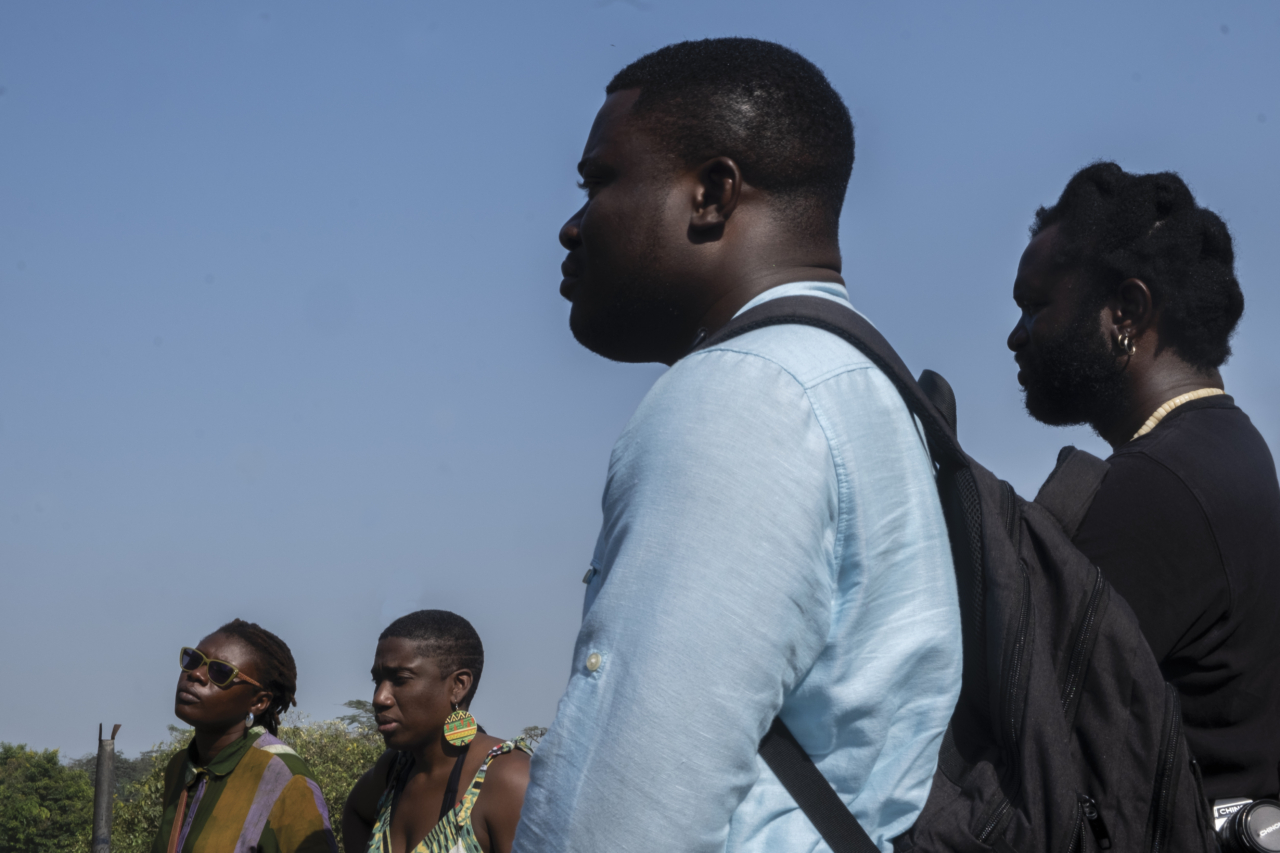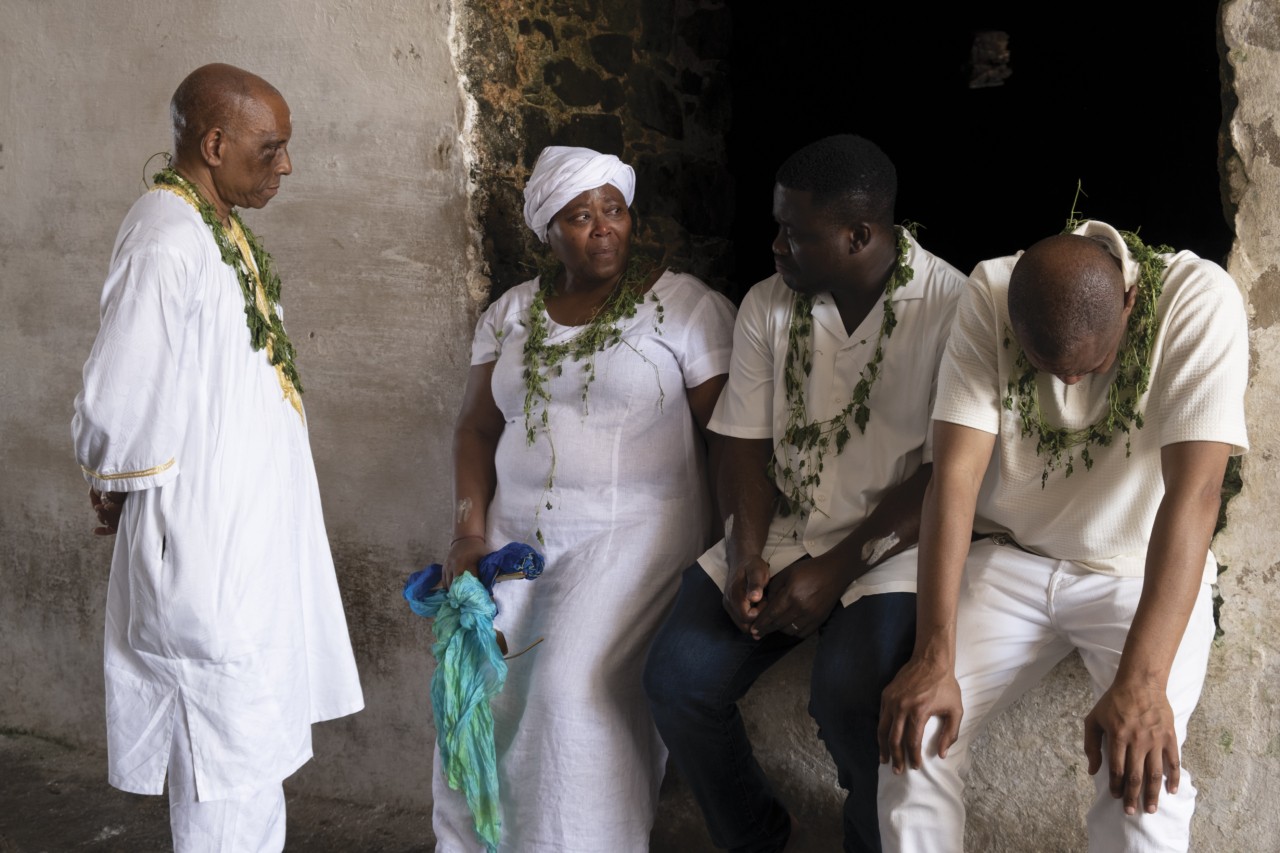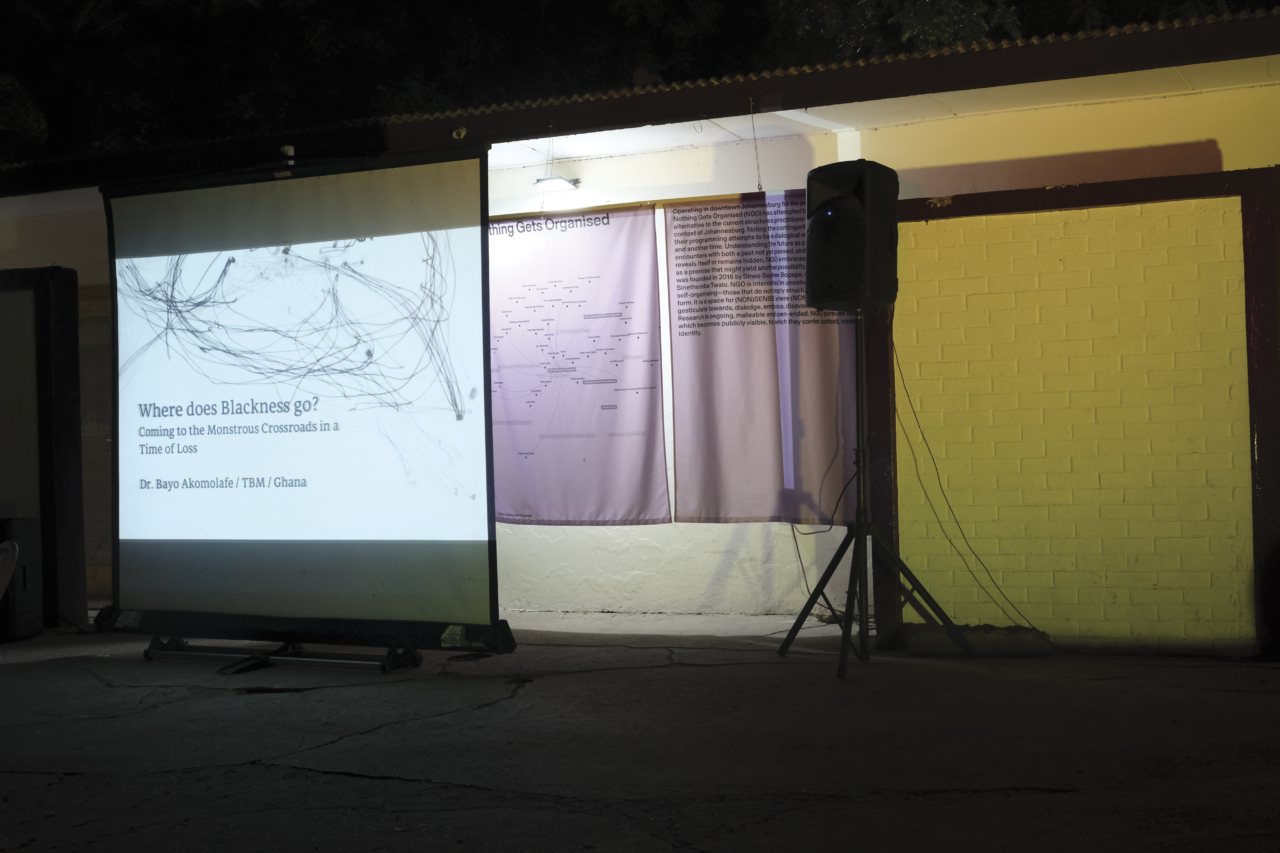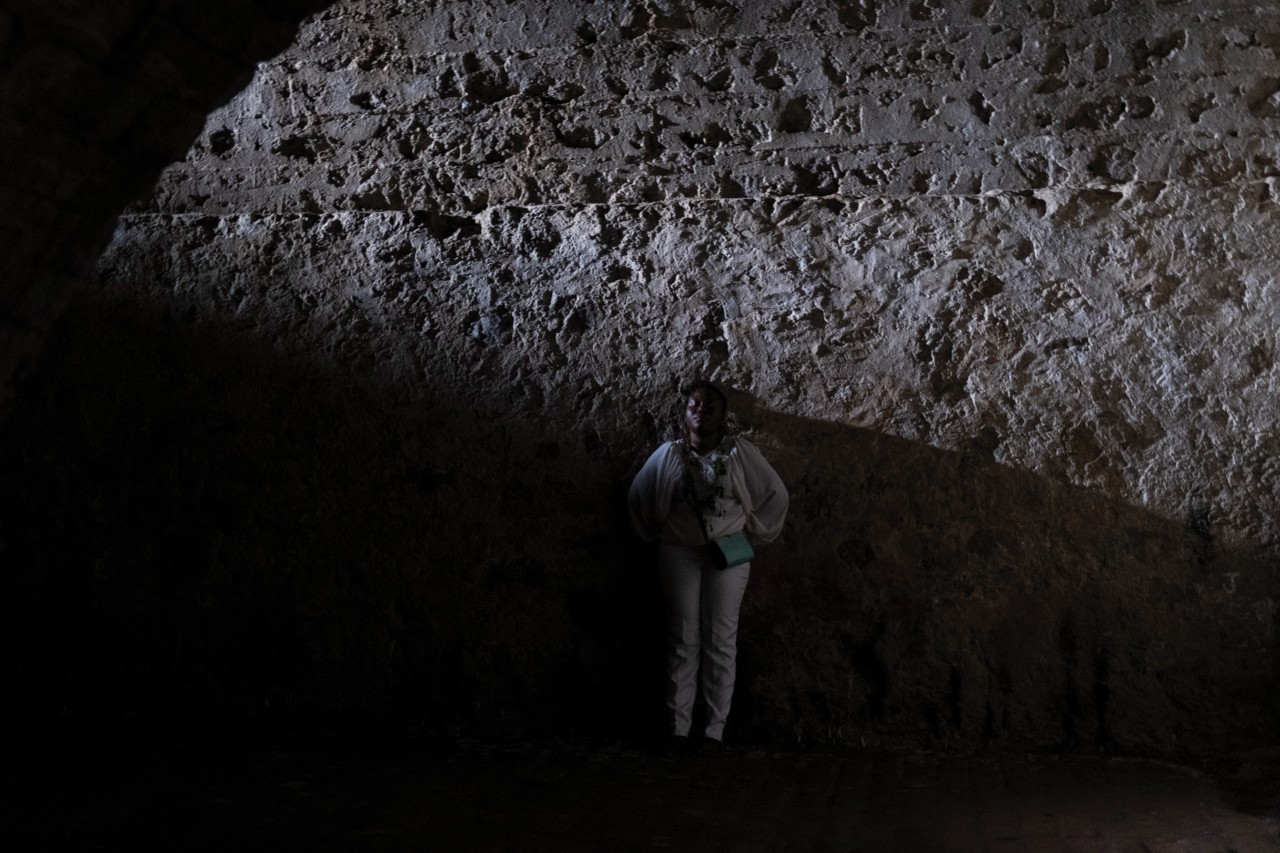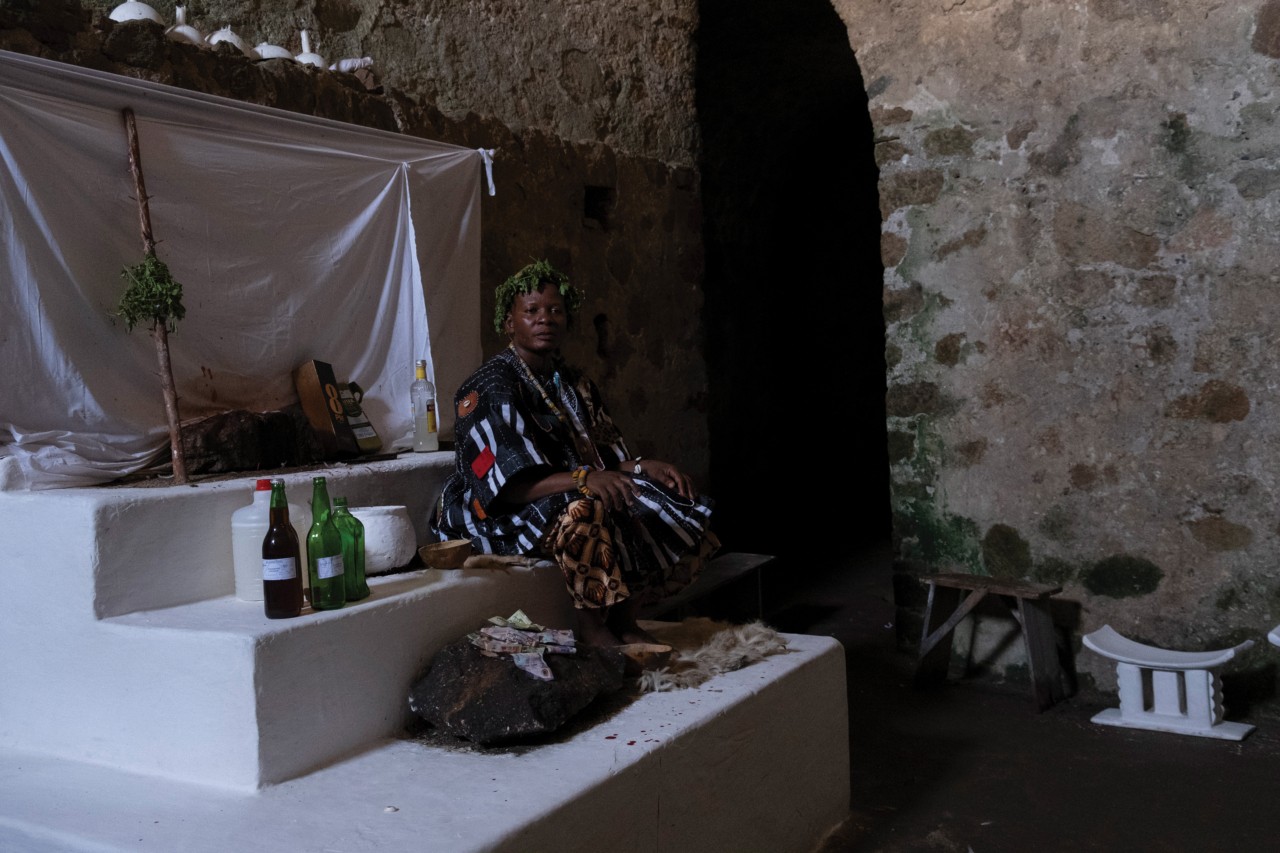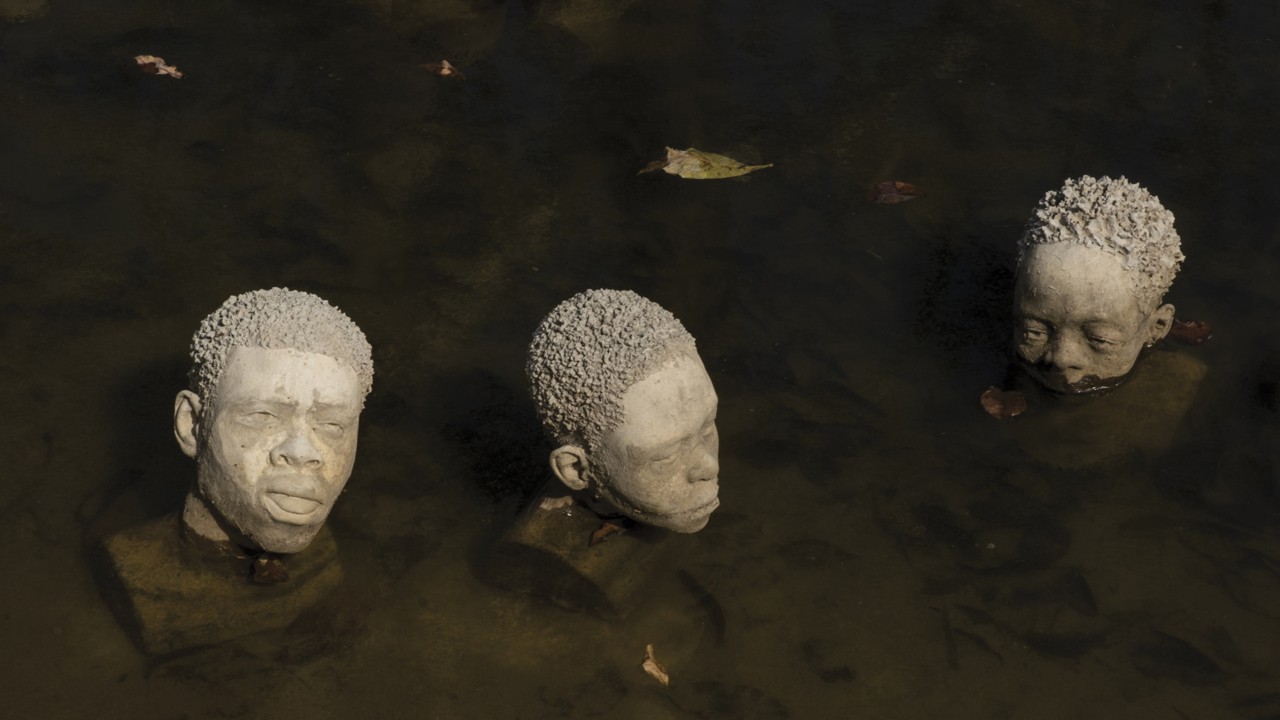
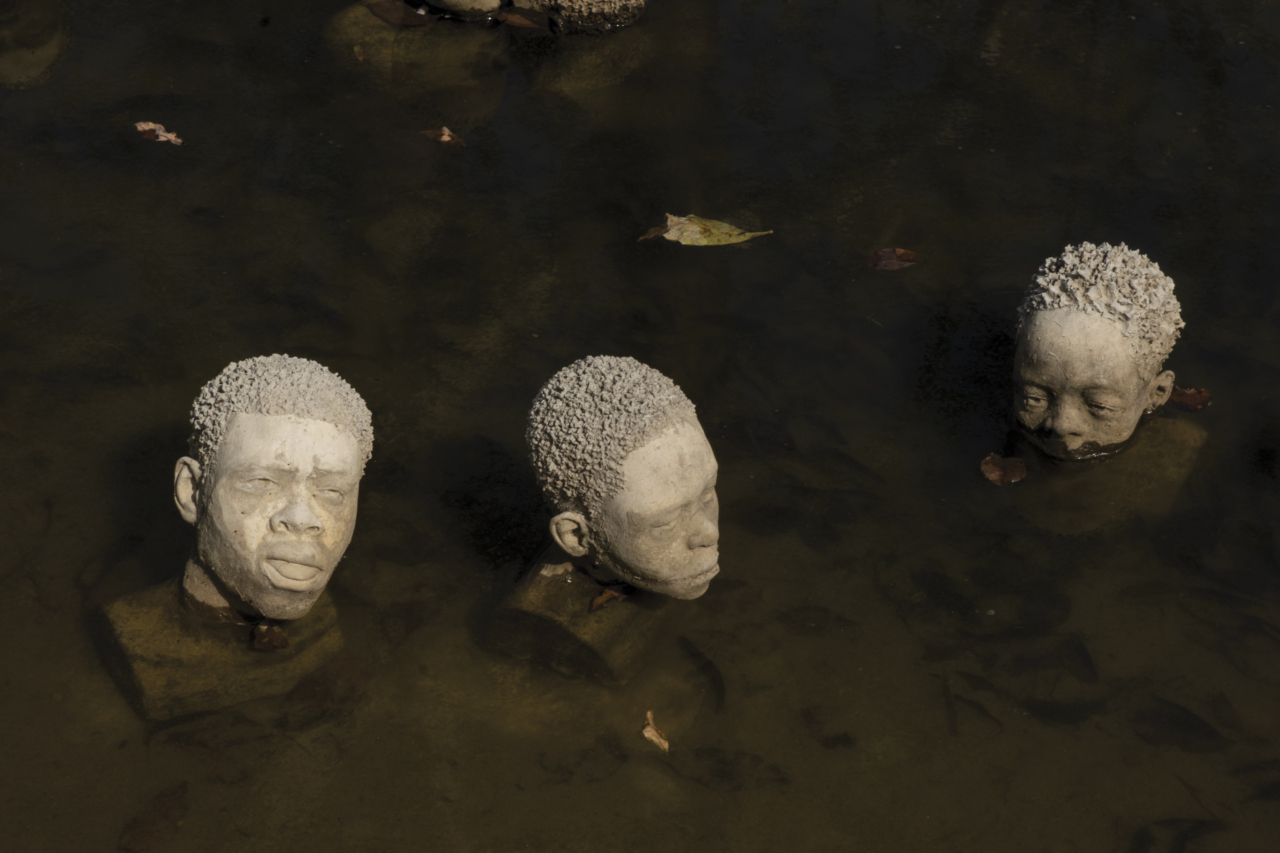
This story is part of a two part series. Read its companion story, In Ghana, a Gathering for Black Joy, Pain, and Reconnection.
Words by Bayo Akomolafe
Photographs by eric gyamfi
For the most part, we were silent on the long bus ride back to our hotel. There wasn’t much to be said. There wasn’t much that could be said. In the silence, we seemed to have left the business of saying things to the vast, undulating fields that frolicked and yawned and stretched outside our windows. To the elderly buildings, curious glances, and inexplicably garlanded red-black poles that dotted the roadside of the Cape Coast. To the jarring and busy traffic noises that marked the beginnings of the sweltering city of Accra. To the dancing spirits of memory that accompanied us along the journey, stitching their tunes to the white of our clothes, playing their drums, urging us never to forget the White of the Cape Coast Castle and the Black of the bodies she ate and spat out from her dungeons.
Our journey to the slave dungeons in Ghana began as a wild seed in the mind of Victoria Santos. She had a dream: to bring together three Black public intellectuals, three Black men she celebrated, to share in the spirit of generosity—a generosity that belies the turbulence of a civilization imperiled by its fixation on anthropocentric imaginaries, burdened by pandemics and genocidal wars, and haunted by the diminishing capacity of its solutions to address its urgent crises.
We met on a Zoom call in the opening months of 2023: Orland Bishop, Resmaa Menakem, and myself.
Somewhere in the digital festivity of our shared embrace, a myth stirred, an unexpected guest—a spiritual-intellectual project that would take us from Los Angeles in the United States, to Bahia in Brazil, and finally to the dungeons in Ghana. We called ourselves the Three Black Men, in part to recognize the Yoruba trickster Èṣù (whose number is three), but also to remember the scandal that once criminalized the gathering of more than two Black persons in the Antebellum South of the United States.


In the months that followed, through the efforts of a village of care that had been convened to accompany us, we would tell a story of home, loss and separation, captivity, intergenerational trauma, and the violence of what Cameroonian philosopher Achille Mbembe called “Black Reason.” From within those stories a plot twist would sprout, our magnum opus: tales of an òrìṣà trickster-god who snuck into the slave ships and creolized the world; conversations about “blackness”—a small-b blackness distinct from the Blackness of identitarian imperatives—that exceeded the traumatic violence of its origins; songs that reminded us that there were worlds beyond the thermal domain of white modernity. In arenas and exquisitely decorated halls, we would speak like crossroads. We would emphasize process, not remedy. We would speak about the promise of losing our way. We would wash the feet of men in Los Angeles, dance with children in a quilombo in Bahia, and linger at the tombs of W. E. B. Du Bois and his wife Shirley in Accra.
But it wasn’t until we stepped into the sprawl of the Cape Coast Castle on the last leg of our reverse-Middle Passage tour, at the final threshold, that our long voyage really began. There, at the Door of Return, the inverted Door of No Return seen from the outside in, I heard the faint lyrics of the strange seafaring cartography that had brought us to the gaping maw of descent—voices whispering that the next electrifying steps to take would lead us into the bitter, dreadful place we had only just emerged from: the dungeons.

If you were to ask me what I feel is the most compelling story of our times of heat and war, I would tell you that it is the story of how we are being spirited away. I mean to say that the settlement is becoming unsettled, displaced by the immensity of a debt that compels us to reconsider our claims to home and mastery. A syncopating wave, a minor gesture, a disabling blast, a creeping excrescence snakes its way through the Anthropocene, igniting heat domes and overloading the circuitries of technobureaucratic responsiveness. Threatening whiteness.
By whiteness, I do not mean “white people.” Such a reduction would be a mistake, an inadequate rendering. Instead, by whiteness, I mean the unspoken conditions that make bodies visible or invisible, tactile or immaterial, obvious or ignoble, useful or discardable. Whiteness—the racializing, terraforming, civilizing morality/aesthetic that flattens worlds and territorializes spaces for the manufacturing and sustenance of separability and separation—precedes and exceeds its Euro-American origins, becoming a globalizing operating system that governs bodies, marks them, eats and spits them out, never quite digesting them. Whiteness’s goal unfurls in the operations of neurotypicality. It seeks to manufacture proper bodies, good bodies, according to predetermined values within the colonial territory of the Human.
Whiteness is the quest for transcendence. The clearing of the wilds to build residential schools in Canada. The importation of Africans to farm plantations in the New World. The pathological marking of Black bodies in nineteenth century Rio de Janeiro with the discarded fecal matter of citizens desirous of a more sophisticated public latrine system. The colonization of African nation-states and the development of a Westphalian order, a managerial matrix of experts, sciences, philanthropic solidarities, and technologies. The construction of dungeons in Cape Coast, Ghana, to pummel the body into usable flesh, good for plantation.
If you were to ask me what I feel is the most compelling story of our times of heat and war, I would tell you that it is the story of how we are being spirited away.
Whiteness is often the intelligence of the revolt, the weapon of the protester, and the reconverging pattern that lurks behind rushed declarations of anticolonial interventions. It is how we eat, how food is processed, how we know the world, how we know ourselves, how we parent our children, and how we name our elders.
And now, cracks are showing up in this formidable world-shaping performance.
Cracks. These otherworldly critters are the erstwhile hidden tensions that threaten the project of white stability, the ways we have practiced belonging, identified ourselves, and marked our territories of selfhood.
Today, the calculations of progress and growth require an impossible math. No longer is the world just background wallpaper to the agential foreground of human actors. Some kind of ontological mutiny now afoot means that white modernity is face to face with threats to its project of sovereignty. And the citizen-subject, historically subsidized by the subterranean screams and sweat beneath the clean surfaces of the city, faces the fate of the ones shoved through the Door of No Return toward waiting vessels.
This is the story of embarkation. A new iteration of being carried away. The loss of white stability. The corrosive, obsidian black, middling passage of Èṣù through the cartographies of the master. The transmutation of the tools of slavery into technologies of experimentation.



The dungeon is not a place per se. It is a place of no place, a placeless place, a “place” to which the locatability of the citizen-subject is beholden, the shadow underbelly of the city’s claims to foundational morality. The dungeon is how whiteness was invented.
And yet, the story of embarkation is the story of how the dungeon, hollowed out but still teeming with the ghosts of the broken, is now becoming a place of memory, of tears of joy, of embrace, of soft returnings, of prophetic imagination, poetry, and experimentation.
I remember being in the amniotic darkness of the Ghanaian dungeon. As the village travelling with the Three Black Men shuffled through the force of ages, through force fields of grief, I lingered in one dungeon “room” where three tiny rectangles betrayed three hesitant streams of light let into the otherwise obsidian space. I felt my way to the closest wall and slumped to the floor—allowing my palms to touch the moist. Then, like a faucet that couldn’t hold the waves roaring through its veins, I wept. I wept and I spoke with rapid, unprepared lyrics of grief-laden poetry. I heard myself speak as if the words weren’t mine.
The voice that spoke thanked the elders whose cells swirled with the moist, cool earth beneath my body. The voice that spoke riffed on the practical arrangements that needed to be made to create a public fit for the dissociative individual, the citizen-subject capably emblematized by the white man, and how that same public was now burning.
Our work is to make sanctuary. To re/turn to this placeless place and decorate it.
I have heard rumours of solar winds sweeping across the surface, turning everything they touch into coal. It’s time to descend. But descend where? Not to a “where,” not to a “place.” blackness has no destinations, no purpose, no convenient and stable cartographies. blackness is not utopia. Descending is a “how,” not a “where.” A placeless place, a process, not a remedy. This dungeon is a how.
The voice that spoke sounded each syllable like it was its last breath, every word cutting through the thick like shrapnel from a mushroom cloud. Every word libated with tears.
Our work is to make sanctuary. To re/turn to this placeless place and decorate it. To catch the bodies discarded by the broken outdoors as the civilizing ethic of whiteness flails under the weight of its own aspirations to hold aloft the mastering self. The rejected stone has now become the chief cornerstone. Such joy. Such joy. Such joy.
Like the biblical Samson, whose killing of a young lion (which later housed a hive of honey-producing bees in its carcass) birthed a riddle that speaks of embarkations, transmutations, and strange becomings—“out of the bitter, something sweet”—blackness comes out of the bitter of dungeons into the sweet of making sanctuary in times of endings and loss.
A politics of the minor gesture is needed now. A politics that can teach us how to travel in low places. A politics of refurbished dungeons and strange hospitalities.
Ghana brought the Three Black Men tour to its end and left us with the seed of journeys to come. Its silences taught us that though the freedoms from dungeons had been won, the vocation of descending must bring us to them once more. We must now turn the machines of coloniality into sanctuaries of experimentation.




This article first appeared in Atmos Volume 9: Kinship with the headline “Part II: Out of the Bitter.”
Bayo Akomolafe on How to Make Sanctuary in Times of Loss
